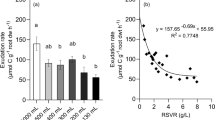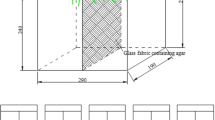Abstract
Mechanical impedance stimulates maize root exudation. The purpose of this work was to evaluate the direct effect of mechanical impedance on root exudation from the indirect effect involving root morphological modifications induced by mechanical impedance. Maize plants were grown in axenic hydroponic culture conditions for 4, 8, 12 and 16 days, and mechanical impedance was simulated by glass beads. At the end of the culture, exudation of plants in a nutrient solution was measured during 24 h. At harvest, plant growth and development parameters as well as carbon exudation were measured. The results demonstrated a major influence of mechanical impedance on root growth with a reduction in root elongation. Comparisons with previous studies in soil conditions have indicated that the glass-bead system realistically simulated mechanical impedance. The carbon exudation rate fluctuated from 0.2 to 1.2 mg C plant-1 day-1 and a fraction of this carbon (0.06 to 0.11 mg C plant-1 day-1) was recovered from glass beads in impeded conditions. The difference in exudation between both treatments for comparable plant morphologies lead to the conclusion that the mechanical impedance had a direct effect on exudation rate. Correlations between plant morphology and root exudation suggest that root morphology is probably involved in the modification of root exudation.
Similar content being viewed by others
References
Abdalla A M, Hettiaratchi D R P and Reece A R 1969 The mechanics of root growth in granular media. J. Agric. Engng. Res. 14, 236–248.
Asady G H and Smucker A J M 1989 Compaction and root modifications of soil aeration. Soil. Sci. Soc. Am. J. 53, 251–254.
Atwell B J 1990 The effect of soil compaction on wheat during early tillering. I. Growth, development and root structure. New Phytol. 115, 29–35.
Barber D A and Gunn K B 1974 The effect of mechanical forces on the exudation of organic substances by the roots of cereal plants grown under sterile conditions. New Phytol 73, 39–45.
Bengough A G and Young I M 1993 Root elongation of seedling peas through layered soil of different penetration resistances. Plant Soil 149, 129–139.
Bengough A G, Croser C and Pritchard J 1997 A biophysical analysis of root growth under mechanical stress. Plant Soil 189, 155–164.
Boeuf-Tremblay V, Plantureux S and Guckert A 1995 Influence of mechanical impedance on root exudation of maize seedlings at two development stages. Plant Soil 172, 279–287.
Gregory P J and Atwell B J 1991 The fate of carbon in pulse-labelled crops of barley and wheat. Plant Soil 136, 205–213.
Hamlen R A, Lukezic F L and Bloom J R 1972 Influence of age and stage of development on the neutral carbohydrate components in root exudates from alfalfa plants grown in a gnotobiotic environment. Can. J. Plant Sci. 52, 633–642.
Hartung W, Zhang J and Davies W J 1994 Does abscissic acid play a stress physiological role in maize plants growing in heavily compacted soil? J Exp. Bot. 45, 221–226.
Helal M and Sauerbeck D 1989 Carbon turnover in the rhizosphere. Z. Pflanzenernahr. Bodenkd. 152: 211–216.
Hoagland D R, Arnon I R 1938 The water culture method for growing plants without soil. University of California, Experimental Station, Circular 347.
Iijima M, Kono Y, Yamauchi A and Pardales J R 1991 Effects of soil compaction on the development of rice and maize root systems. Environ. Exp. Bot. 31, 333–342.
Kraffczyk I, Trolldenier G and Beringer H 1984 Soluble exudates of maize: influence of potassium supply and rhizosphere microorganisms. Soil Biol. Biochem. 16, 315–322.
Lindberg S and Pettersson S 1985 Effects of mechanical stress on uptake and distribution of nutrients in barley. Plant Soil 83, 295–309.
Masle J and Passioura J B 1987 The effect of soil strength on the growth of young wheat plants. Aust. J. Plant Physiol. 14, 297–303.
Nantawisarakul T and Newman I A 1992 Growth and gravitropism of corn roots in solution. Plant Cell Environ. 15, 693–701.
Pearson R and Parkinson D 1961 The sites of excretion of ninhydrinpositive substances by broad-bean seedlings. Plant Soil 13, 391–396.
Pfeffer W 1893 Druck und arbeitsleistung durch wachsende Pflanzen. Abh. Saechs. Akad. Wiss. 33, 235–474.
Rovira A D 1969 Plant root exudates. Bot. Rev. 35, 35–57.
Rovira A D and McDougall B 1965. Carbon-14 labelled photosyntate in wheatroot exudates. Nature, London 5001, 1104–1105.
Russell R S 1977 Plant Root Systems. Their Function and Interaction with the Soil. McGraw-Hill, Maidenhead.
Samtsevich S A 1965 Active excretions of plants roots and their significance. Soviet Plant Physiol. 12, 731–740. (English translation).
Sarquis J L, Jordan W R and Morgan P W 1991 Ethylene evolution from maize seedling roots and shoots in response to mechanical impedance Plant Physiol. 96, 1171–1177.
Sauerbeck D R and Helal H M 1986 Plant root development and photosynthetate consumption depending on soil compaction. In Transactions XIII. Congr. Int. Soc. Soil Sci. 3, 948–949.
Scholefield D and Hall D M 1985 Constricted growth of grass roots through rigid pores. Plant Soil 85, 153–162.
Schonwitz R and Ziegler H 1982 Exudation of water-soluble vitamins and of some carbohydrates by intact root maize seedlings (Zea mays) into a mineral nutrient solution. Z. Pflanzenphysiol. 107, 7–14.
Veen BW and Boone FR 1990 The influence of mechanical resistance and soil water on the growth of seminal roots of maize. Soil Tillage Res. 16, 219–226.
Wiersum L K 1957 The relationship of the size and structural rigidity of pores to their penetration by roots. Plant Soil 9, 75–85.
Wilson A J, Robards A W and Goss M J 1977 Effects of mechanical impedance on root growth in barley (Hordeum vulgare L.). II Effects on cell development in seminal roots. J. Exp. Bot. 28, 1216–1228.
Wolkowski R P 1990 Relatioship between wheel-traffic-induced soil compaction, nutrient availability and crop growth: A review. J. Prod. Agric. 3, 460–469.
Author information
Authors and Affiliations
Rights and permissions
About this article
Cite this article
Groleau-Renaud, V., Plantureux, S. & Guckert, A. Influence of plant morphology on root exudation of maize subjected to mechanical impedance in hydroponic conditions. Plant and Soil 201, 231–239 (1998). https://doi.org/10.1023/A:1004316416034
Issue Date:
DOI: https://doi.org/10.1023/A:1004316416034




